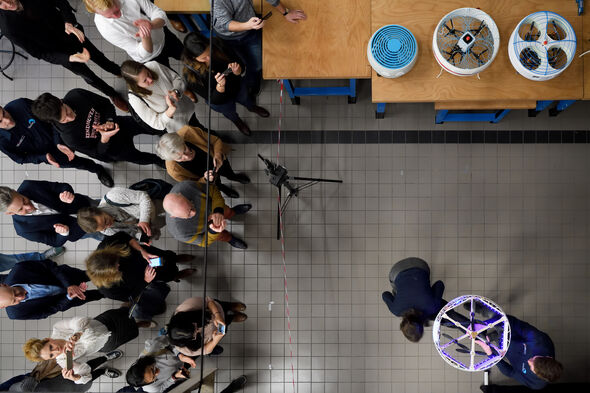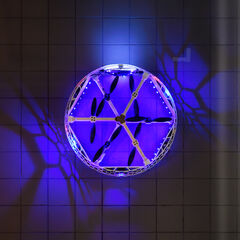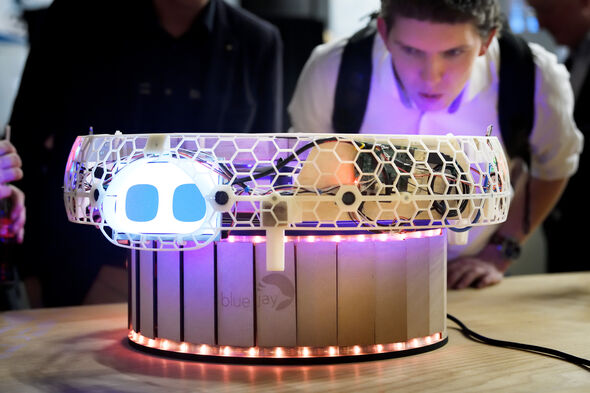Blue Jay dreams of a patient-monitoring drone
A drone that can monitor patients, that detects irregularities in, say, breathing or heart rhythm and, wherever possible, responds - all this is still a pipe dream, but Blue Jay Eindhoven hopes to make it happen. Yesterday evening the TU/e student team presented its latest prototype to various partners.
Exploring the possibilities, seeking the limits of the possible - in Blue Jay's discussions with hospitals, care institutions, and others everything revolves around this approach, emphasizes team manager Liza Boormans. “We are in discussion with nurses and patients as well as with board members to learn how they think a drone can best be used in somewhere like a hospital.”
Keeping an eye on groups of people has proven to be a need that is repeatedly mentioned, explains Boormans. She notes, among other things, the staff shortages in many areas of the care system. In detecting an emergency, such as a fall or irregular breathing, and in taking the next steps, a drone could play an important role; this is the shared belief of Blue Jay and various of its partners.
By way of an initial test, the team is keen to add to its latest prototype a sensor capable of measuring a person's breathing at a distance of a few meters. The recorded data is sent to a nurse who, via a mobile application, can see the values of various patients and receives an immediate report if an irregularity occurs. “Ultimately, we'd like the drone go ahead and take the next step, which may be to fetch something that assists the nurse in helping a patient - such as a defibrillator.” One of the challenges involved is that a drone is never entirely still in the air; it makes tiny circular movements. “This is an aspect we are testing thoroughly.”
Read on below the video.
Boormans emphasizes that this is all about a long-term vision, and that a real-life application will be something for a future team: “There are so many aspects to be tackled before a drone is ready to actually be used in, say, a hospital. For starters, think of the noise a drone makes; that's an ongoing challenge.” But, she adds, the noise made by Blue Jay's latest prototype has a much lower tone and is therefore much easier on the ear than its predecessor.
The drone's size (currently 60 centimeter in diameter) is another issue. “We'd rather have it a fair bit smaller if it's going to be working around people. On the other hand, the propeller has to be a certain size because our drone needs to have enough power to, say, pick up objects.”
Read on below the photo.
Another challenge is the drone's ‘flight time’ before it needs recharging. “There is currently a drone that can fly for 45 minutes,” knows Yasmine Bartelds, electrical engineer with Blue Jay. “But I hope that in time our drone will be able to complete much longer tasks.” In view of this, the student team is currently working on a landing station, “a home base for the drone where it can also be recharged,” says Boormans.
Ultra-wideband instead of light cage
This year has seen a lot of tinkering with the fundamentals of the drone's flying. Whereas last year it needed a kind of 'light cage' full of lamps to orient itself and maneuver its own through space, now use is being made of ultra-wideband, a wireless technology that involves positioning a number of tags both in space and on the drone itself. “By emitting a certain frequency, the drone can use these tags to position itself in space,” says Boormans. “What's especially nice is that this also works in the dark and, for example, through walls.” What's more, for the first time the drone can turn on its axis, thanks to a new internal compass.
Blue Jay's latest drone weighs 1.8 kilos; quite a bit less than the previous one. This has partly been achieved by using lighter materials, such as balsawood for the internal frame. The 3D-printed external frame in which all the electrical components are housed is openwork; it has a honeycomb structure.
For now the team is focusing on getting the drone to fly independently. “And we also want to show that it can negotiate obstacles. Walls, a table, a tall plant, as well as moving people.” Arranged around its bright blue ‘eyes’ are four sonars that can detect dynamic obstacles with the aid of sound.
Electrical engineer Bartelds says she realizes that the development of drone technology seems to many people to be progressing slowly. “But it is a entirely new technology, everything has to be brought together in the proper way. Similarly, the cell phone as we know it today wasn't developed in a year.” Above all, she stresses, a drone is in many ways a more complex machine than, say, a robot that moves across the ground. While TU/e care robot AMIGO, whose skills include object recognition, might be a dab hand with a Kinect camera: “That is much too heavy for a drone”.
Team manager Boormans chimes in: “If you could set up a large company here with a staff of three hundred, the development and production would be much faster. We are a student team with eighteen people, most of them working part time. What's more, there aren't really any competitions or other recurring events that we can compete in because by far the most teams are focused on drone racing. There are others who are working on functional drones, but most of them are concentrating on outdoor use.”
![[Translate to English:] Foto | Bart van Overbeeke](/fileadmin/_processed_/9/b/csm_BvOF_presentatie_Blue_Jay_drone_5_b166c3fda4.jpg)




Discussion